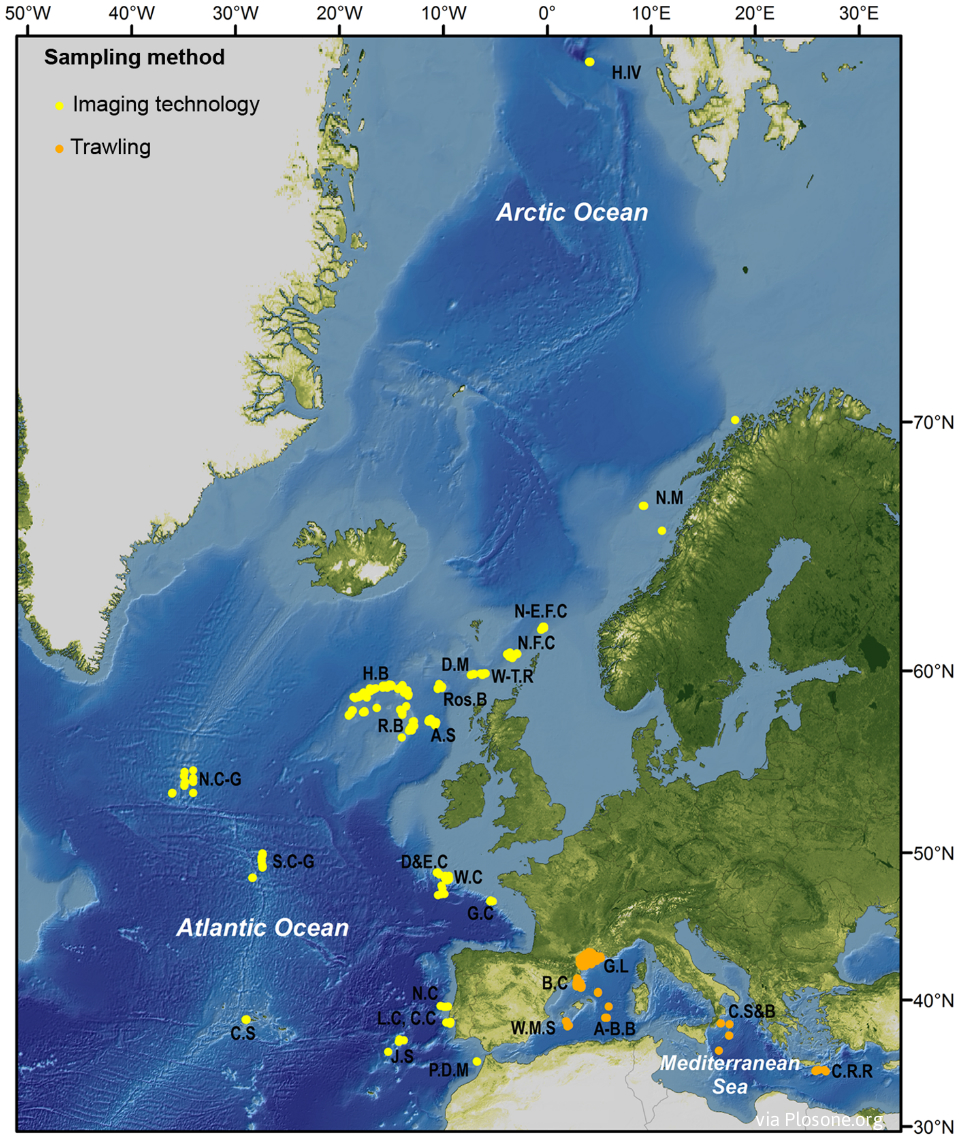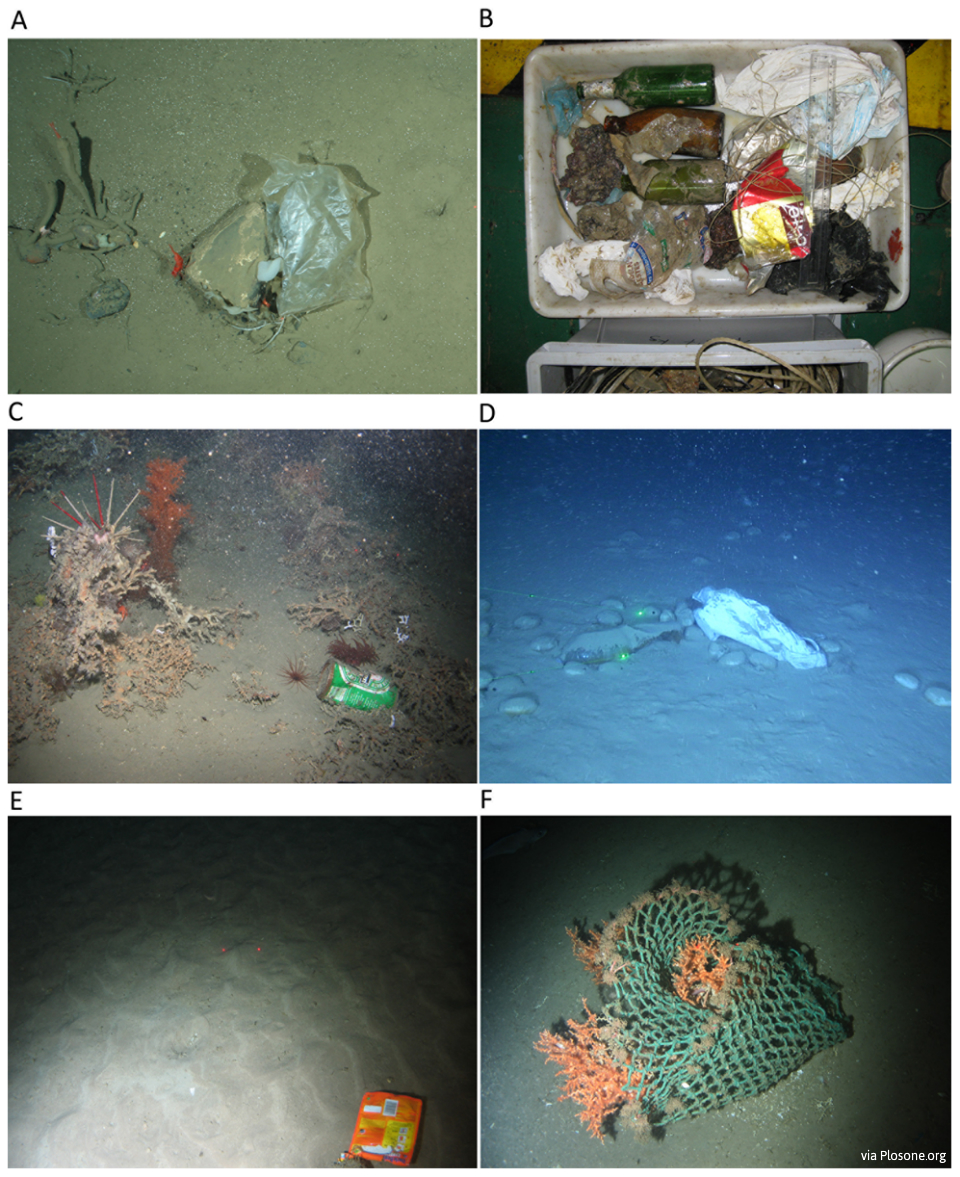Filtered By: Scitech
SciTech
Plastic trash has gone where no man has gone before
By MACY AÑONUEVO
A large-scale study of the European seafloor has found trash in all their sampling locations, to a depth of as much as 4.5 km below the surface—in areas where humans have even yet to explore.
Scientists consolidated data from 588 video and trawl "transects" collected by various survey cruises in 32 sites in the northeast Atlantic Ocean, Arctic Ocean, and Mediterranean Sea over a 10-year period.
Sampling locations were classified into six categories:
Sampling locations were classified into six categories:
- continental shelves
- continental slopes
- submarine canyons
- seamounts, banks, and mounds
- ocean ridges, and
- deep basins

Locations of the study sites saLocations of the study sites sampled with imaging technology (ROVs, manned submersible, towed camera systems) and trawling.
Trash seen in videos and photographs or collected in trawls were classified as plastic, derelict fishing gear (nets and lines), metal, glass, clinker (the residue of burnt coal), and others (paper, cardboard, fabric, wood, and unidentified items). Plastic bags, glass bottles, and derelict fishing gear were the most common litter items seen, with plastic composing 41% of total litter items, followed by derelict fishing gear (34%). Plastic was also found in 98% of trawls.
Trash was also found in all of the survey areas – from sites near population centers such as the Gulf of Lion in the Mediterranean to as far as the South Charlie-Gibbs Fracture Zone in the Mid-Atlantic Ridge, about 2,000 km from land. Submarine canyons were accumulation zones of land-based trash with 9.3 ± 2.9 (SE) items per hectare, the highest found in the study. Plastic was the most abundant litter category in submarine canyons, continental shelves, and continental slopes.

Litter items on the seafloor of European waters. (A) Plastic bag entrapped by a small drop stone harbouring sponges (Cladorhiza gelida, Caulophacus arcticus), shrimps (Bythocaris sp.) and a crinoid (Bathycrinus carpenterii) recorded by an OFOS at the HAUSGARTEN observatory (Arctic) at 2500 m; (B) Litter recovered within the net of a trawl in Blanes open slope at 1500 m during the PROMETO V cruise on board the R/V “García del Cid”; (C) “Heineken” beer can in the upper Whittard canyon at 950 m water depth with the ROV Genesis; (D) Plastic bag in Blanes Canyon at 896 m with the ROV “Liropus”; (E) “Uncle Benn's Express Rice” packet at 967 m in Darwin Mound with the ROV “Lynx” (National Oceanography Centre, UK); (F) Cargo net entangled in a cold-water coral colony at 950 m in Darwin Mound with the ROV “Lynx” (National Oceanography Centre, UK).
Co-author Dr. Kerry Howell said, "This survey has shown that human litter is present in all marine habitats, from beaches to the most remote and deepest parts of the oceans. Most of the deep sea remains unexplored by humans, and these are our first visits to many of these sites, but we were shocked to find that our rubbish has got there before us." Lead author Christopher Pham added, "The large quantity of litter reaching the deep ocean floor is a major issue worldwide. Our results highlight the extent of the problem and the need for action to prevent increasing accumulation of litter in marine environments."
Scientists haven't been able to get a comprehensive look at the extent and composition of marine trash until now as surveying the deep seas is a very expensive endeavor. This study was funded by the European Union as part of the Hotspot Ecosystem Research and Man's Impact on European Seas (HERMIONE) project (http://www.eu-hermione.net/), a consortium of 38 partners from 13 countries around Europe, which ran from 2009 to 2012.
Researching the deep ocean
Humans are not built for underwater exploration. The maximum recommended depth for a recreational diver breathing surface air is 40 meters. In contrast, Challenger Deep, the deepest point of the Mariana Trench, is located 11.03 kilometers below the ocean’s surface. More people have been to the moon than to Challenger Deep.
To safely stay at depth long enough to do research, humans must use vehicles. Some of the data used in this study was obtained using the manned submersible JAGO, rated at maximum depth of 400 meters and the only manned research sub in Germany. However, due to the cost associated with manned trips, scientists may opt to use remotely operated vehicles (ROVs), towed camera systems, or trawls instead.
Trash isn’t unique to the European seabed. All of the deepwater trawls in the Verde Island Passage done during the 2011 Hearst Philippine Biodiversity Expedition collected plastic, including the trawl at 2.35 kilometers depth. Said Dr. Rich Mooi, “In some of the trawls, the amount of plastic from garbage exceeded the organisms that we were collecting in that same haul”.
Marine trash affects the environment in various ways. Discarded fishing nets and lines become "ghost fishers" as they continue to catch various organisms such as fish, turtles, and dolphins as they float then sink to the bottom. Floating trash also become havens for assorted larvae that are then transported to areas beyond their natural geographical limits, where they become invasive species. Trash may also be mistaken for food and ingested by animals, such as when sea turtles mistake floating plastic bags for jellyfish. These plastics then block the digestive system and the animal starves to death. Humans can also be affected by trash located far away from them. Plastic fragments contain persistent organic pollutants (POPs) such as polychlorinated biphenyls. These may accumulate in consumer tissues and be transferred up the food chain to predators, including humans. — TJD, GMA News
Macy Añonuevo earned her MS Marine Science degree from the University of the Philippines. She is a published science and travel writer and was a finalist in the 2013 World Responsible Tourism Awards under the Best Photography for Responsible Tourism category. Her writings and photographs may be found at www.theislandergirl.com.
More Videos
Most Popular



